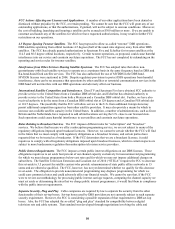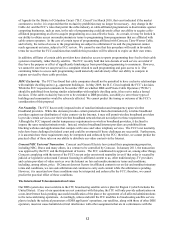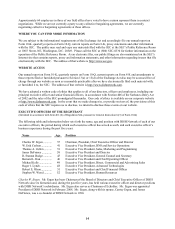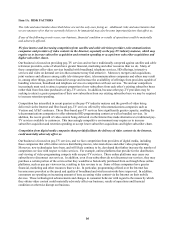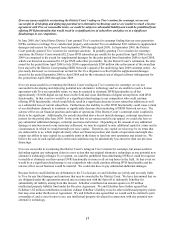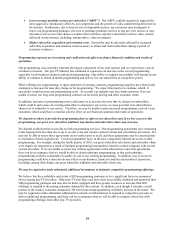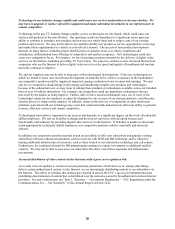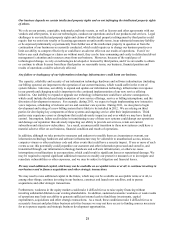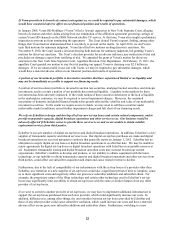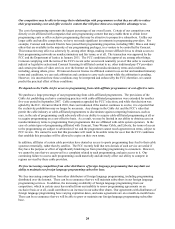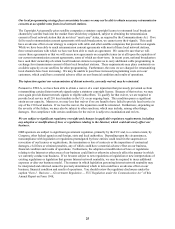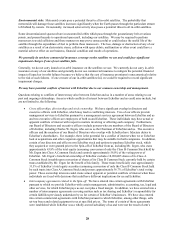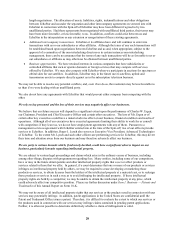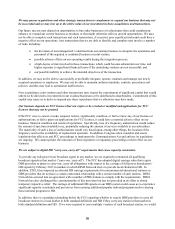Dish Network 2010 Annual Report Download - page 27
Download and view the complete annual report
Please find page 27 of the 2010 Dish Network annual report below. You can navigate through the pages in the report by either clicking on the pages listed below, or by using the keyword search tool below to find specific information within the annual report.
20
20
Technology in our industry changes rapidly and could cause our services and products to become obsolete. We
may have to upgrade or replace subscriber equipment and make substantial investments in our infrastructure to
remain competitive.
Technology in the pay-TV industry changes rapidly as new technologies are developed, which could cause our
services and products to become obsolete. Our operating results are dependent to a significant extent upon our
ability to continue to introduce new products and services on a timely basis and to reduce costs of our existing
products and services. We may not be able to successfully identify new product or service opportunities or develop
and market these opportunities in a timely or cost-effective manner. The success of new product development
depends on many factors, including proper identification of customer need, cost, timely completion and
introduction, differentiation from offerings of competitors and market acceptance. New technologies could also
create new competitors for us. For instance, we face increasing consumer demand for the delivery of digital video
services via the Internet, including providing TV Everywhere. We expect to continue to face increased threats from
companies who use the Internet to deliver digital video services as the speed and quality of broadband and wireless
networks continues to improve.
We and our suppliers may not be able to keep pace with technological developments. If the new technologies on
which we intend to focus our research and development investments fail to achieve acceptance in the marketplace,
our competitive position could be negatively impacted causing a reduction in our revenues and earnings. We may
also be at a competitive disadvantage in developing and introducing complex new products and technologies
because of the substantial costs we may incur in making these products or technologies available across our installed
base of over 14 million subscribers. For example, our competitors could use proprietary technologies that are
perceived by the market as being superior. Further, after we have incurred substantial costs, one or more of the
technologies under our development, or under development by one or more of our strategic partners, could become
obsolete prior to it being widely adopted. In addition, delays in the delivery of components or other unforeseen
problems associated with our technology may occur that could materially and adversely affect our ability to generate
revenue, offer new services and remain competitive.
Technological innovation is important to our success and depends, to a significant degree, on the work of technically
skilled employees. We rely on EchoStar to design and develop set-top boxes with advanced features and
functionality and solutions for providing digital video services via the Internet. If EchoStar is unable to attract and
retain appropriately technically skilled employees, our competitive position could be materially and adversely
affected.
In addition, our competitive position depends in part on our ability to offer new subscribers and upgrade existing
subscribers with more advanced equipment, such as receivers with DVR and HD technology and by otherwise
making additional infrastructure investments, such as those related to our information technology and call centers.
Furthermore, the continued demand for HD programming continues to require investments in additional satellite
capacity. We may not be able to pass on to our subscribers the entire cost of these upgrades and infrastructure
investments.
Increased distribution of video content via the Internet could expose us to regulatory risk.
As a result of recent updates to certain of our programming agreements which allow us to, among other things,
deliver certain authenticated content via the Internet, we are increasingly distributing content to our subscribers via
the Internet. The ability to continue this strategy may depend in part on the FCC’s success in implementing rules
prohibiting discrimination of content that is distributed over the networks owned by broadband and wireless Internet
providers. For more information, see “Item 1. Business — Government Regulations — FCC Regulations under the
Communications Act — Net Neutrality” of this Annual Report on Form 10-K.


